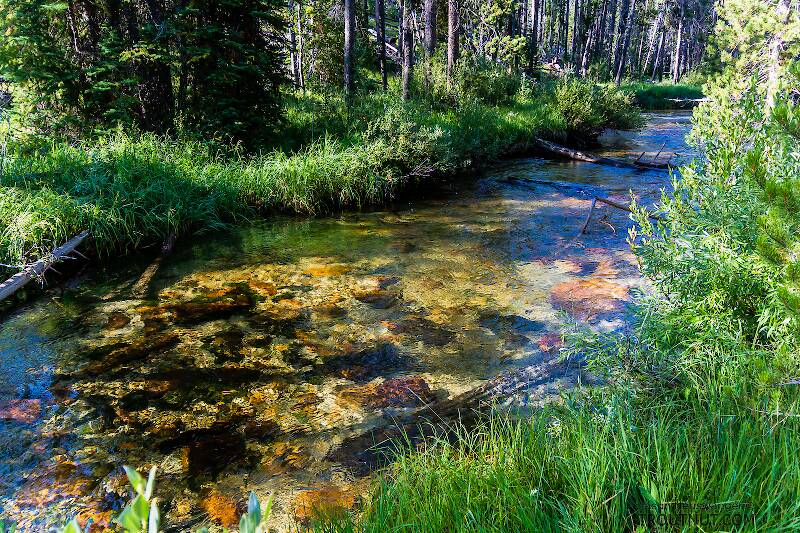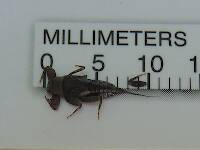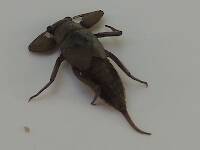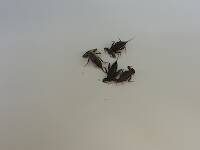
Hex Mayflies
Hexagenia limbata
The famous nocturnal Hex hatch of the Midwest (and a few other lucky locations) stirs to the surface mythically large brown trout that only touch streamers for the rest of the year.
Featured on the forum

This one pretty clearly keys to Kogotus, but it also looks fairly different from specimens I caught in the same creek about a month later in the year. With only one species of the genus known in Washington, I'm not sure about the answer to this ID.

Troutnut is a project started in 2003 by salmonid ecologist Jason "Troutnut" Neuswanger to help anglers and
fly tyers unabashedly embrace the entomological side of the sport. Learn more about Troutnut or
support the project for an enhanced experience here.
Byhaugh on Dec 16, 2013December 16th, 2013, 2:56 pm EST
sHi,
I am new here.
I have a question. I know there is (or may be) a difference between an Eastern Blue Winged Olive and a Western Blue Winged Olive?
My question is this. I have always heard the Blue Winged Olive referred to as a Baetis - both in the Midwest and out West.
I am looking at the little publications "Compara-hatch" by Caucci and Nastasi. In the little stream side identification phamplet, they identify the Ephemerella Attenuata as the Blue-Winged Olive.
I think their work was done primarily on Eastern rivers. At what geographic location does the Blue Winged Olive change from Ephemerella Attenuata to Baetis while, all the while, retaining its common name as a Blue-Winged Olive?
Thanks,
Byron
I am new here.
I have a question. I know there is (or may be) a difference between an Eastern Blue Winged Olive and a Western Blue Winged Olive?
My question is this. I have always heard the Blue Winged Olive referred to as a Baetis - both in the Midwest and out West.
I am looking at the little publications "Compara-hatch" by Caucci and Nastasi. In the little stream side identification phamplet, they identify the Ephemerella Attenuata as the Blue-Winged Olive.
I think their work was done primarily on Eastern rivers. At what geographic location does the Blue Winged Olive change from Ephemerella Attenuata to Baetis while, all the while, retaining its common name as a Blue-Winged Olive?
Thanks,
Byron
Taxon on Dec 16, 2013December 16th, 2013, 6:25 pm EST
Hi Byron-
Welcome to Troutnut.com. When someone asks a question involving both mayfly common names and mayfly taxononic names, it is often impossible to answer that question with much precision. However, I will do my best.
As you say, Blue-Winged Olive is a mayfly common name, which is used by fly fishers to refer to numerous genera and species of family Baetidae (Small Minnow Mayfly), at least one of which is found nearly every USA state.
Conversely, Blue-Winged Olive is also a mayfly common name used by fly fishers to refer to several genera and species of family Ephemerellidae (Spiny Crawler Mayfly) primarily found in the eastern USA states.
Hope this helps.
Welcome to Troutnut.com. When someone asks a question involving both mayfly common names and mayfly taxononic names, it is often impossible to answer that question with much precision. However, I will do my best.
As you say, Blue-Winged Olive is a mayfly common name, which is used by fly fishers to refer to numerous genera and species of family Baetidae (Small Minnow Mayfly), at least one of which is found nearly every USA state.
Conversely, Blue-Winged Olive is also a mayfly common name used by fly fishers to refer to several genera and species of family Ephemerellidae (Spiny Crawler Mayfly) primarily found in the eastern USA states.
Hope this helps.
Crepuscular on Dec 16, 2013December 16th, 2013, 6:47 pm EST
Hi Byron. Welcome to TN. This topic comes up pretty often. I like to think of common names for mayflies as the general name of the fly pattern (Parachute BWO or BWO Spinner) and the taxonomic name as the name of the insect.
Like Rodger said, there are some mayfly species from both the Baetis and other Baetidae genera and the family Ephemerellidae that are called blue-winged olives whenever and wherever they are found. For some more info this check this out http://www.troutnut.com/common-name/8/Blue-Winged-Olives.
So really geography does not play a role other than in one area of North America, a particular mayfly species may have a common name that is different than the common name of the same mayfly in a different area of the continent. Or a mayfly of a single species may not exist all parts of North America but yet have the same common name as a completely different species that occurs in a separate geographical area.
And if you want to add to the confusion, Ephemerella attenuata is no longer a valid taxonomic name. It is now Attenella attenuata.
Like Rodger said, there are some mayfly species from both the Baetis and other Baetidae genera and the family Ephemerellidae that are called blue-winged olives whenever and wherever they are found. For some more info this check this out http://www.troutnut.com/common-name/8/Blue-Winged-Olives.
So really geography does not play a role other than in one area of North America, a particular mayfly species may have a common name that is different than the common name of the same mayfly in a different area of the continent. Or a mayfly of a single species may not exist all parts of North America but yet have the same common name as a completely different species that occurs in a separate geographical area.
And if you want to add to the confusion, Ephemerella attenuata is no longer a valid taxonomic name. It is now Attenella attenuata.
Oldredbarn on Dec 17, 2013December 17th, 2013, 12:04 pm EST
Clear as mud, boys! ;)
Spence
Spence
"Even when my best efforts fail it's a satisfying challenge, and that, after all, is the essence of fly fishing." -Chauncy Lively
"Envy not the man who lives beside the river, but the man the river flows through." Joseph T Heywood
"Envy not the man who lives beside the river, but the man the river flows through." Joseph T Heywood
Crepuscular on Dec 17, 2013December 17th, 2013, 1:50 pm EST
Clear as mud, boys! ;)
Spence
I know. Why don't you clear it up for us. ;) I should've let this one go. Rodger did just fine without me mucking it up
Entoman on Dec 17, 2013December 17th, 2013, 11:09 pm EST
Welcome, Byron!
You are pretty spot on regarding the use (or rather misuse) of the name regionally.
The name has its origins in English FF literature going back to antiquity and has been universally adopted over there as the common one for their only green bodied species of ephemerellid. They use it to describe no other mayfly species. When an English angler mentions to another that "the Blue-winged Olives were coming off" they both know EXACTLY the insect in question. Simple and nonconfusing. Unfortunately, the sheer size and scope of the diversity in our fauna precludes such tidiness. The gray winged olive bodied color scheme is by far the most common in the order with examples being found in almost every family here in North America. Species that can be called Blue-winged Olive (and indeed have been) are legion. Though mostly applied improperly in the West it has been misused back East as well.
More humor can be found on this topic than almost any other in our archives. In an attempt to resolve the confusion, Gonzo came up with the idea of calling eastern ephemerellids with green bodies the lyrical name "Morning Olive Duns." My thoughts were that regardless of geography, only olive ephemerellids should be rightly called BWO's (respecting our literary heritage going back hundreds of years) and olive baetids should be called "Olive Quills." Alas, too simple and orderly for our community to ever adopt in practice. :)
You are pretty spot on regarding the use (or rather misuse) of the name regionally.
The name has its origins in English FF literature going back to antiquity and has been universally adopted over there as the common one for their only green bodied species of ephemerellid. They use it to describe no other mayfly species. When an English angler mentions to another that "the Blue-winged Olives were coming off" they both know EXACTLY the insect in question. Simple and nonconfusing. Unfortunately, the sheer size and scope of the diversity in our fauna precludes such tidiness. The gray winged olive bodied color scheme is by far the most common in the order with examples being found in almost every family here in North America. Species that can be called Blue-winged Olive (and indeed have been) are legion. Though mostly applied improperly in the West it has been misused back East as well.
More humor can be found on this topic than almost any other in our archives. In an attempt to resolve the confusion, Gonzo came up with the idea of calling eastern ephemerellids with green bodies the lyrical name "Morning Olive Duns." My thoughts were that regardless of geography, only olive ephemerellids should be rightly called BWO's (respecting our literary heritage going back hundreds of years) and olive baetids should be called "Olive Quills." Alas, too simple and orderly for our community to ever adopt in practice. :)
"It's not that I find fishing so important, it's just that I find all other endeavors of Man equally unimportant... And not nearly as much fun!" Robert Traver, Anatomy of a Fisherman
Quick Reply
Related Discussions
Topic
Replies
Last Reply
1
Apr 18, 2007
by Troutnut
by Troutnut
1
Jul 22, 2006
by Taxon
by Taxon
0
Oct 24, 2006
by Troutnut
by Troutnut
2
Sep 10, 2010
by Taxon
by Taxon








